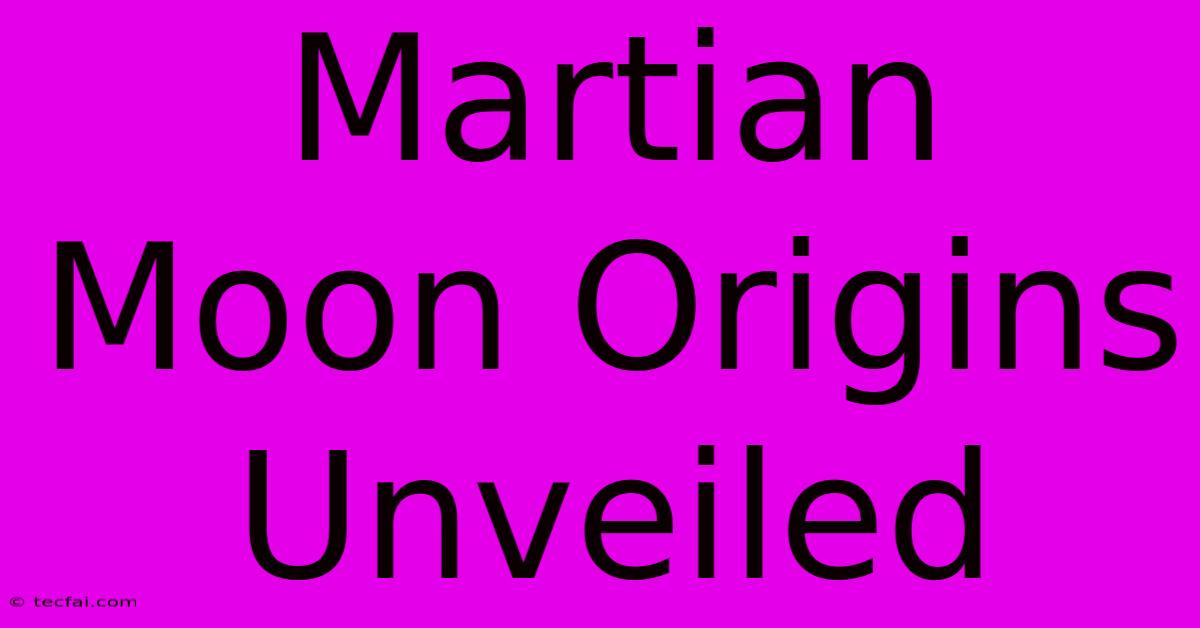Martian Moon Origins Unveiled

Discover more detailed and exciting information on our website. Click the link below to start your adventure: Visit Best Website tecfai.com. Don't miss out!
Table of Contents
Martian Moon Origins Unveiled: A New Chapter in Planetary Science
The Martian moons, Phobos and Deimos, have long captivated scientists with their enigmatic origins. These small, irregularly shaped satellites are unlike any other moons in our solar system, prompting decades of speculation and debate. Recent research, however, is beginning to shed light on their mysterious past, offering a compelling new narrative about their formation. This article delves into the latest discoveries, exploring the prevailing theories and their implications for our understanding of planetary formation and evolution.
The Phobos and Deimos Puzzle: Why are they so Unusual?
Unlike the smooth, spherical moons orbiting gas giants like Jupiter and Saturn, Phobos and Deimos are pockmarked, oddly shaped, and relatively small. Their low density and dark, carbonaceous composition further distinguish them. These characteristics have ruled out several traditional moon-formation theories, such as the accretion disk model that successfully explains the formation of many other moons. This has led to the development of alternative, more intriguing hypotheses.
The Captured Asteroid Hypothesis: A Leading Contender
For many years, the most widely accepted theory proposed that Phobos and Deimos were captured asteroids. This hypothesis suggests that these bodies originated in the asteroid belt and were subsequently gravitationally captured by Mars's gravitational pull. The irregular shapes and composition of the moons seemed to support this idea, mirroring the characteristics of many asteroids.
However, this theory has faced challenges. The precise mechanics of capturing an asteroid are complex, requiring specific conditions to effectively slow it down enough for capture. Recent simulations have found that the probability of successfully capturing a body the size of Phobos or Deimos is surprisingly low.
A New Theory Emerges: The Giant Impact Hypothesis Revisited
A growing body of evidence now supports a revised giant-impact hypothesis. This theory proposes that Phobos and Deimos are remnants of a colossal collision between Mars and a large planetesimal – a smaller celestial body – early in the solar system's history. This impact would have ejected a significant amount of Martian material into orbit, eventually coalescing to form the moons.
This theory neatly explains several aspects of Phobos and Deimos’s characteristics. The similar composition to Martian mantle material, though requiring further study, supports this origin. Furthermore, the irregular shapes can be attributed to the chaotic accretion of debris from the impact.
Supporting Evidence: Spectroscopic Analysis and Orbital Dynamics
Recent spectroscopic analysis of Phobos's surface has revealed compositional similarities to Martian rocks, bolstering the giant impact theory. Furthermore, the moons' orbital characteristics, particularly their relatively low inclinations, are more consistent with formation from a debris disk following a giant impact than with a capture scenario.
Unanswered Questions and Future Research
While the giant impact hypothesis gains traction, several questions remain. The exact size and nature of the impacting planetesimal are still debated, as is the precise process by which the debris coalesced into Phobos and Deimos. Future missions, particularly those involving sample return from Phobos, are crucial to further refine our understanding. Detailed analysis of the Martian moon's composition will help constrain models and provide a more definitive answer.
Conclusion: A Deeper Understanding of Our Solar System's History
The ongoing investigation into the origins of Phobos and Deimos represents a significant step forward in our comprehension of planetary formation and evolution. By exploring the mysteries of Mars's moons, we gain invaluable insights into the violent and dynamic processes that shaped our solar system billions of years ago. The emerging giant impact theory offers a compelling narrative, yet further research and technological advancements are needed to conclusively unravel this fascinating chapter in our cosmic history. The ongoing quest to understand the Martian moons promises many more exciting discoveries in the years to come.

Thank you for visiting our website wich cover about Martian Moon Origins Unveiled. We hope the information provided has been useful to you. Feel free to contact us if you have any questions or need further assistance. See you next time and dont miss to bookmark.
Featured Posts
-
Fog Lifts After Flight Cancellations
Nov 26, 2024
-
Harbowl John Harbaughs Crucial 4th Down Decision
Nov 26, 2024
-
Will It Snow Thanksgiving Storm Outlook
Nov 26, 2024
-
Maui Woman Missing Father Found Dead
Nov 26, 2024
-
Harbaugh Brothers Monday Night Showdown
Nov 26, 2024
